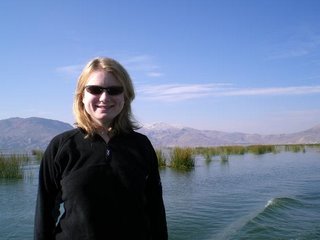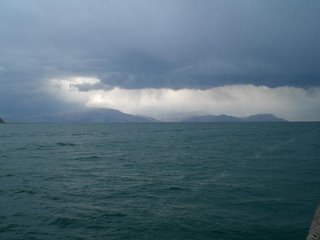Our tour began at 6.45 am on Thursday (one of far too many early starts this week!) and we headed down to the harbour where numerous similar tour boats (30 passenger) were setting sail. When you see the lake you can understand the significance of the altitude thing - sorry to keep going on about it! - as it really does see like you are very close to the sky but also you have the sensation of being on the sea. Really hard to explain and totally stunning, hope that the photos do it justice.
Anyway, our first stop was only about 20 minutes away from Puno - the Uros floating islands. Although they now have mod cons including solar power, and are visited by many tourists each day, the Uros people still live on floating islands as they have for many generations and use reeds to make just about everything. The totora reeds are used to build their houses, for food, for crafts and most fundamentally to build the islands themselves. As well as tasting the reeds, we also had the chance to ride on a reed boat - it was definitely one of the most interesting and totally different experiences we have had so far.
We then set sail again for the 2.5 hour trip to Taquile island. The closest comparison I can find is that it felt like we were on a Greek Island. It was very easy to forget that we were actually in a lake not the sea! The water was calm and crystal clear and the whole island was very tranquil in spite of the tourists. In many ways it seemed like the islanders there had been able to maintain their traditions and simple way of life in a way that the Uros hadn´t and I suppose that their distance from the mainland helped with this. One interesting fact is that the male islanders wear different hats to denote their marital status, or different again if they were authority figures. The community is clearly strong, work is carried out by everyone and the fact that many people live into their 90s didn´t surprise me, not least when I saw a man who was probably around 70 carrying a clearly heavy load of wood up steep steps.
So all in all we had a very lovely and interesting day with a great guide, and as we headed back we were happily admiring the view from the top of the boat. However, just to add a bit more excitement, we spotted a large number of grey clouds gathering ahead of us and when the lightning really started we hastily made our way back inside our now very flimsy seeming vessel. Not like me to panic in choppy water (Mum & Dad remember the Mauritius boat trip I´m sure!) and Andrew wondering out loud about how many boats had been struck by lightning really didnt help. What really freaked me out however, was when the driver started saying some kind of blessing over coca leaves (yes, they are used for everything) before throwing them into the lake! Then the hail started, the boat rocked even more and I started seriously asking myself what I was doing in a not entirely new small vessel in the middle of a Peruvian lake (highest in the world or not!) - especially one that had no form of windscreen wipers!
Needless to say we made it back to dry land with no real problems, and it is probably something that happens every day (see Andrew´s post re weather). My sense of adventure is well and truly still intact you´ll be pleased to hear and it has been a very memorable day to end our fascinating 3 weeks in Peru. Onwards to La Paz early (boo!) tomorrow.


No comments:
Post a Comment